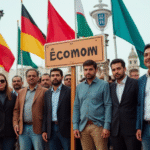Historical Context of Mexico’s Economic Transformation
During the presidencies of Miguel de la Madrid and Carlos Salinas, there was a significant push to transition from a closed economy with limited foreign imports to one that embraced exporting goods and services abroad. This shift, however, faced certain restrictions promoted by José López Portillo. Internally, efforts were made to liberate markets, deregulate economic activity, and foster long-term growth, albeit with less success. During these two administrations, Mexico joined the General Agreement on Tariffs and Trade (GATT), now known as the World Trade Organization, and began signing international free trade agreements. This has led to Mexico having the most such instruments today.
The T-MEC and Its Current Status
Despite President Andrés Manuel López Obrador’s decision not to personally sign the T-MEC proposed by President Donald Trump, opting instead for former President Peña Nieto to do so before his term ended, it’s crucial to note that the Senate, with a majority from all parties including Morena, ratified the agreement.
Mexico City’s Mayor Claudia Sheinbaum’s Stance
Mexico City’s Mayor Claudia Sheinbaum has consistently advocated for maintaining and expanding open international trade, even seeking new markets to complement the substantial trade with the U.S. She has been determined to prevent her trading partner’s strategy of promoting protectionism. The concessions she has made are primarily based on avoiding a tariff exchange game. While the benefits of free trade should be visible in Mexico’s southern entities, which have been largely excluded from these benefits for the past 32 years of trade integration with the world, the T-MEC renegotiation began a year earlier due to Norteamerica’s stronger regional economy. The aim is to prevent Mexico, in collaboration with Canada, from exerting undue pressure on their primary partner.
Key Questions and Answers
- What is the T-MEC? The T-MEC, or United States-Mexico-Canada Agreement, is a trade agreement that replaced the North American Free Trade Agreement (NAFTA) in 2020.
- Why is the T-MEC being reviewed? The review is prompted by changes in the regional economic dynamics, particularly the stronger economy of Norteamérica, and to prevent potential imbalances in trade relations.
- Who ratified the T-MEC? The Mexican Senate, with a majority from all parties including Morena, ratified the T-MEC.
- What is Mexico City’s Mayor’s stance on trade? Mayor Claudia Sheinbaum supports maintaining and expanding open international trade, aiming to complement existing trade with the U.S. by exploring new markets and preventing protectionist strategies.






